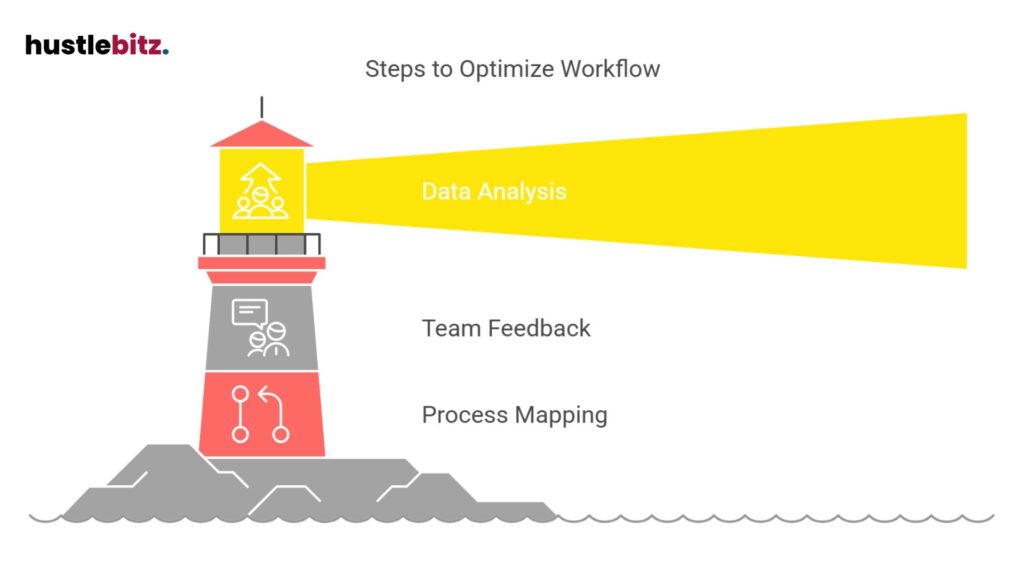To optimize your workflow for maximum efficiency, start by assessing your current processes and identifying bottlenecks. Conduct thorough analyses and gather team insights to uncover inefficiencies. Set clear goals and prioritize tasks based on urgency and importance. Leverage productivity tools to automate repetitive tasks and enhance collaboration. Implement effective time management techniques, such as time-blocking and the Pomodoro Technique, to improve focus. Streamline communication by defining protocols and promoting regular check-ins. Lastly, ensure effective task delegation by aligning tasks with team members’ strengths. Exploring these strategies will enhance your operational effectiveness significantly. Discover further insights on elevating your workflow.
Key Takeaways
- Conduct a thorough workflow analysis to identify inefficiencies and redundancies in task completion.
- Implement automation for repetitive tasks to focus on high-value activities and boost overall productivity.
- Set clear goals and prioritize tasks based on urgency and importance to enhance resource allocation.
- Utilize collaboration platforms for real-time communication and centralized information sharing to streamline processes.
- Regularly reassess workflows and gather team feedback to foster continuous improvement and adapt to changing needs.

Assessing Your Current Workflow

To effectively optimize your workflow for efficiency, it is essential to first conduct a thorough assessment of your current processes and identify areas for improvement.
Assessing your current workflow involves a detailed workflow analysis that examines how tasks are completed within your existing workflow. This evaluation should encompass various factors, including task duration, resource allocation, and overall effectiveness in meeting objectives.
Begin by mapping out your current processes, documenting each step involved from initiation to completion. This visual representation allows you to pinpoint redundancies and inefficiencies. Engage team members in discussions regarding their experiences with the current workflow, as their insights can provide valuable information about bottlenecks or areas that hinder productivity.
Once you have a comprehensive understanding of your existing workflow, consider implementing workflow optimization strategies tailored to your specific context. These strategies may include streamlining processes, automating repetitive tasks, or reallocating resources to critical areas to enhance productivity. The goal is to improve workflow efficiency by eliminating unnecessary steps and ensuring that each task contributes meaningfully to the overall objective.
Regularly revisiting your workflow assessment is crucial, as it allows you to adapt to changes in your operational environment and continuously seek improvement. By diligently assessing your current workflow and proactively addressing areas for enhancement, you position your organization to thrive in a competitive landscape, ultimately leading to increased efficiency and effectiveness in achieving your goals.
Identifying Bottlenecks and Challenges
Identifying bottlenecks and challenges within your workflow is a critical step that can significantly impact overall efficiency and productivity. A bottleneck occurs when a specific stage in your process slows down the entire workflow, hindering performance and delaying outcomes. Recognizing these issues enables you to implement effective workflow optimization tips to improve workflow and streamline your workflow.
To effectively identify bottlenecks, consider the following strategies:
- Data Analysis: Examine performance metrics and timelines to pinpoint stages where delays frequently occur.
- Team Feedback: Engage team members to gather insights about their experiences and frustrations within the workflow.
- Process Mapping: Visualize your workflow to highlight dependencies and areas where tasks may be piling up.

By focusing on these areas, you can identify bottlenecks that disrupt workflow performance. Once recognized, it becomes possible to develop targeted solutions. For instance, reallocating resources, automating repetitive tasks, or revising processes can help alleviate pressure points.
Moreover, fostering a culture of continuous improvement encourages team members to regularly assess and provide feedback on the workflow. This proactive approach not only addresses current challenges but also anticipates potential ones in the future. Ultimately, by diligently identifying and addressing bottlenecks, organizations can enhance overall efficiency, leading to improved outcomes and a more effective workflow.
Setting Clear Goals and Priorities
Establishing clear goals and priorities is essential for streamlining workflow and enhancing productivity within any organization. When teams engage in setting clear goals, they create a unified vision that guides their efforts, allowing each member to understand their roles and responsibilities. This clarity is crucial for effective workflow optimization, as it helps to eliminate confusion and miscommunication.
To improve efficiency, organizations should prioritize their goals based on urgency and importance. This prioritization ensures that resources are allocated to the most critical tasks, which in turn enhances process workflow. By focusing on high-impact activities, teams can achieve significant results within shorter timeframes, thereby increasing overall productivity.
Moreover, setting clear goals allows for the establishment of measurable performance indicators. By tracking progress against these indicators, teams can identify areas for improvement and adjust their strategies accordingly. This iterative process not only fosters accountability but also encourages continuous improvement in workflows.
It is important to involve team members in the goal-setting process, as this fosters a sense of ownership and commitment to the objectives. When employees understand the broader organizational goals and how their contributions fit into that framework, they are more likely to remain motivated and engaged.
Leveraging Productivity Tools

Productivity tools serve as essential assets for organizations aiming to streamline processes and enhance overall efficiency in their workflows. Leveraging these tools can significantly transform how tasks are approached, leading to substantial improvements in performance and productivity. By integrating workflow optimization software and automation tools, companies can establish an efficient workflow that maximizes output while minimizing resource expenditure.
Key benefits of utilizing productivity tools include:
- Task Automation: Reduce manual effort by automating repetitive tasks, allowing employees to focus on higher-value activities.
- Seamless Collaboration: Foster teamwork through platforms that enable real-time communication and file sharing, ensuring everyone is on the same page.
- Enhanced Tracking: Utilize tools that provide insights and analytics for workflow management, helping to identify bottlenecks and areas for improvement.
By adopting these technologies, businesses can boost productivity and create a more dynamic work environment. Workflow optimization software can facilitate better project management, enabling teams to prioritize tasks effectively and meet deadlines consistently. Furthermore, automation tools not only save time but also reduce the likelihood of human error, contributing to the overall quality of work produced.
Incorporating these productivity tools into daily operations is no longer an option but a necessity for organizations looking to remain competitive. As workflows become increasingly complex, the right tools will empower teams to work smarter, not harder, ultimately driving success and profitability.
Implementing Time Management Techniques

Effectively managing time is crucial for enhancing workflow efficiency and ensuring that tasks are completed within set deadlines.
Time management techniques play a vital role in workflow optimization, allowing individuals and teams to allocate their resources better and prioritize tasks effectively. By adopting these techniques, organizations can significantly increase both efficiency and productivity.
One of the most effective strategies to improve workflow efficiency is implementing workflow optimization methods, such as the Pomodoro Technique. This method encourages focused work sessions followed by short breaks, enhancing concentration and reducing burnout.
Additionally, utilizing time-blocking allows individuals to assign specific time periods to distinct tasks, ensuring dedicated attention and minimizing distractions.
Moreover, integrating workflow automation tools can further aid in time management. Automation reduces the time spent on repetitive tasks, allowing employees to focus on higher-value activities. By streamlining processes through automation, organizations can achieve significant improvements in productivity.
Setting clear goals and deadlines is another essential strategy. By defining what needs to be accomplished and by when, individuals can better prioritize their tasks and allocate time accordingly.
Regularly reviewing and adjusting these goals ensures that teams remain aligned and can respond quickly to changing circumstances.
Streamlining Communication Processes

Regularly streamlining communication processes is essential for enhancing collaboration and reducing misunderstandings within teams. By focusing on these processes, organizations can create a more streamlined workflow that fosters a culture of clarity and efficiency.
Effective communication not only enables team members to share ideas and feedback but also contributes significantly to workflow optimization.
To achieve this, consider implementing the following strategies:
- Utilize collaborative tools: Employ platforms that encourage real-time collaboration, such as project management software or communication apps. These tools provide a centralized space for discussions and file sharing, reducing the chances of miscommunication.
- Establish clear protocols: Define communication guidelines that outline when and how team members should communicate. This includes specifying preferred channels for different types of messages, ensuring that everyone is on the same page.
- Encourage regular check-ins: Foster a culture of open dialogue through routine meetings or check-ins. This practice not only ensures that team members stay aligned but also allows for addressing potential issues promptly.

Delegating Tasks Effectively

Building on streamlined communication processes, delegating tasks effectively is vital for maximizing team efficiency and ensuring that workloads are balanced appropriately. In the context of project management, this practice not only enhances accountability but also empowers team members by aligning tasks with their strengths and expertise.
To implement effective delegation, it is essential to identify the right individuals for specific tasks. This alignment requires a clear understanding of team members’ skills, availability, and professional development goals. By matching tasks to the right people, organizations can achieve significant workflow improvement, which in turn leads to increased productivity.
Incorporating workflow optimization best practices, such as establishing clear objectives and timelines, can further enhance the delegation process. This clarity minimizes confusion and sets expectations, thus fostering a sense of ownership among team members. Additionally, utilizing technology to automate routine tasks can free up valuable time, allowing employees to focus on higher-value activities.
Regular check-ins and feedback loops are also crucial components of effective task delegation. These practices ensure that team members remain aligned with project goals while providing opportunities for support and guidance as needed.
Final Thoughts
Optimizing your workflow for maximum efficiency is a multifaceted process that involves thorough assessment, strategic planning, and the integration of the right tools and techniques. By conducting a detailed analysis of your current workflow, identifying bottlenecks, and setting clear goals, you lay the foundation for a more streamlined and productive work environment. Leveraging productivity tools and implementing time management strategies further enhances this process, enabling you to focus on high-value tasks and improve overall performance. Effective communication and task delegation are also crucial components, ensuring that teams are aligned and working cohesively toward common objectives. By consistently revisiting and refining these strategies, you can foster a culture of continuous improvement, leading to sustained success and increased operational efficiency




